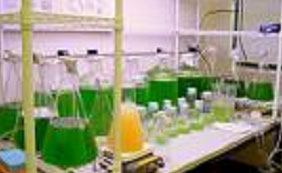Positive features of biofuels

Biodiesel (or biofuel) is the name for a variety of ester-based fuels (fatty esters) generally defined as the monoalkyl esters made from vegetable oils, such as soybean oil, canola or hemp oil, or sometimes from animal fats through a simple transesterification process. This renewable source is as efficient as petroleum diesel in powering unmodified diesel engine.
Rudolf Diesel firmly believed the utilization of a biomass fuel to be the real future of his engine. He wanted to provide farmers the opportunity to produce their own fuel. In 1911, he said "The diesel engine can be fed with vegetable oils and would help considerably in the development of agriculture of the countries which use it".
Today's diesel engines require a clean-burning, stable fuel operating under a variety of conditions. In the mid 1970s, fuel shortages spurred interest in diversifying fuel resources, and thus biodiesel as fatty esters was developed as an alternative to petroleum diesel. Later, in the 1990s, interest was rising due to the large pollution reduction benefits coming from the use of biodiesel. The use of biodiesel is affected by legislation and regulations in all countries (Knothe G, Inform 2002, 13, 900). On February 9, 2004, the Government of the Philippines directed all of its departments to incorporate one percent by volume coconut biodiesel in diesel fuel for use in government vehicles. The EU Council of Ministers adopted new pan-EU rules for the detaxation of biodiesel and biofuels on October 27, 2003. Large-volume production occurs mainly in Europe, with production there now exceeding 1.4 million tons per year. Western European biodiesel production capacity was estimated at about 2 million metric tons per year largely produced through the transesterification process, about one-half thereof in Germany (440,000 and 350,000 MT in France and Italy, respectively). In the United States, by 1995, 10 percent of all federal vehicles were to be using alternative fuels to set an example for the private automotive and fuel industries. Several studies are now funded to promote the use of blends of biodiesel and heating oil in USA. In USA soybean oil is the principal oil being utilized for biodiesel (about 80,000 tons in 2003). Details may be viewed on-line through the National Biodiesel Board web site.
Biodiesel is the only alternative fuel that runs in any conventional, unmodified diesel engine. (How Diesel Engines Work – from How Stuff Works) (Ethanol when used in significant quantities will require modifications in gasoline engines)
· Biodiesel can be used alone or mixed in any ratio with petroleum diesel fuel. The most common blend however is a mix of 20% biodiesel with 80% petroleum diesel, or "B20."
· Biodiesel is about 10% oxygen by weight and contains no sulfur. The lifecycle production and use of biodiesel produces approximately 80% less carbon dioxide emissions, and almost 100% less sulfur dioxide. Similar benefits accrue from ethanol / biogasoline as well.
· Combustion of biofuels alone provides considerable reduction (over 90% for Biodiesel) in total unburned hydrocarbons, and a 75-90% reduction in aromatic hydrocarbons. When burned in a diesel engine, biodiesel replaces the exhaust odor of petroleum diesel with the pleasant smell of popcorn or french fries. Biodiesel further provides significant reductions in particulates and carbon monoxide than petroleum diesel fuel. Thus, biofuels provide significant reduction in cancer risks. In sum, the use of biodiesel & biogasoline will also reduce the following emissions:
- carbon monoxide (Carbon Monoxide Emissions – from Carbon Monoxide Kills)
- ozone-forming-hydrocarbons
- hazardous diesel particulates of solid combustion products
- acid rain-causing sulfur dioxide (Info about Acid Rain, from EPA)
- lifecycle carbon dioxide
· The use of biodiesel can extend the life of diesel engines because it is more lubricating than petroleum diesel fuel (Biodiesel Lubricity – from University of Idaho – PDF), while fuel consumption, auto ignition, power output, and engine torque are relatively unaffected by biodiesel.
· Biofuels are safe to handle and transport because they are biodegradable, much less toxic than even table salt, and have high flashpoints of about 300 F compared to gasoline and petroleum diesel fuel (diesel has a flash point of 125 F, for comparison). (Biodiesel Chemical Safety Data – Oxford Univ). Biodiesel has a very high flash point (300°F) making it one of the safest of all alternative fuels, from a combustibility point. (Biodiesel Flash Point – from Biodiesel Now Forums)
Any copying and distributing the material of Ukrainian Biofuel Portal
without active hyperlink is stricly prohibited !
Link to this news: Positive features of biofuels
Copy & Paste This Code to your website:
Views: 11550 Added: 15-01-2009
Average Rating:
Positive features of biofuels








